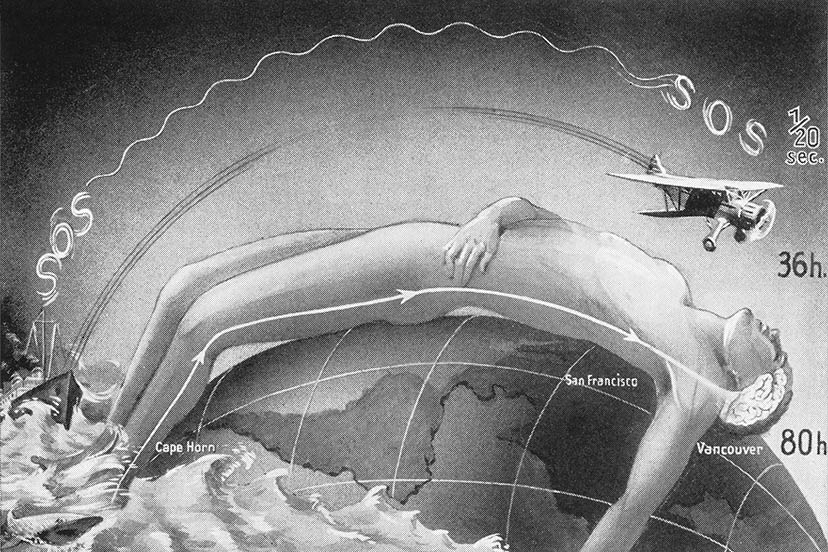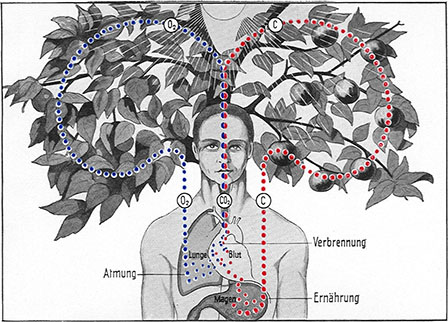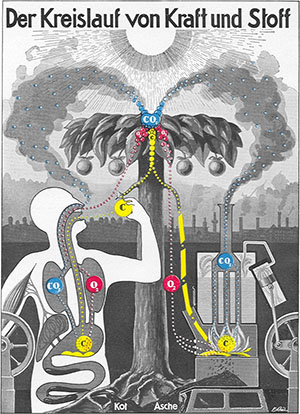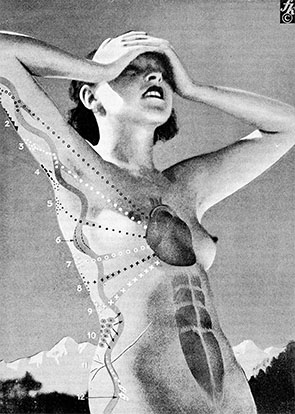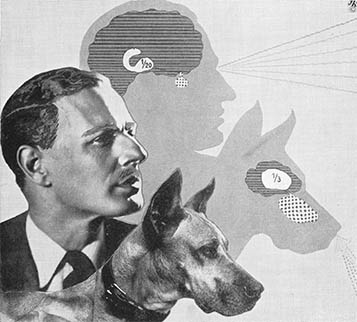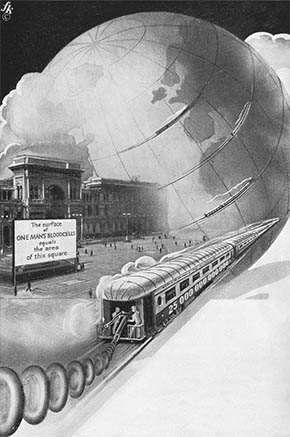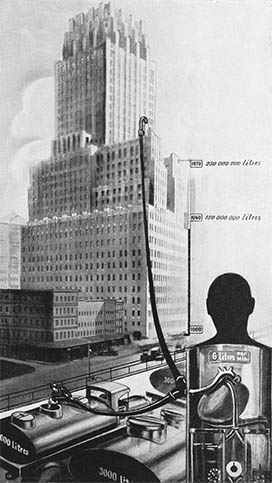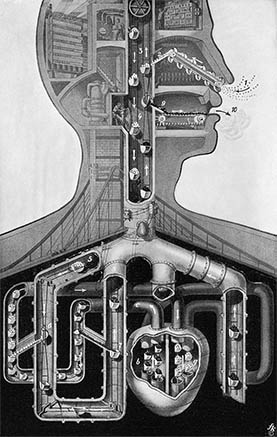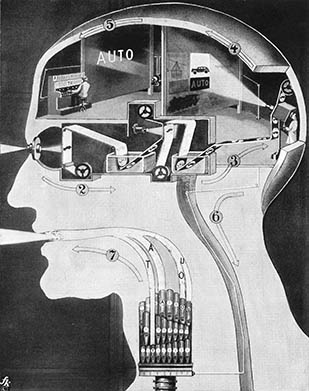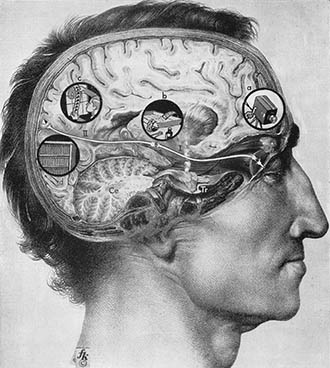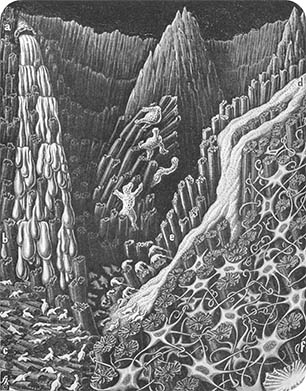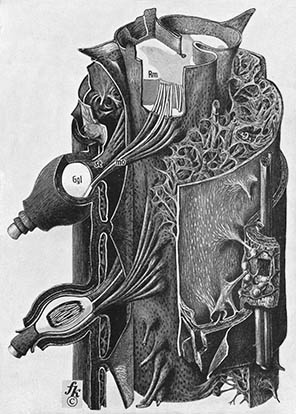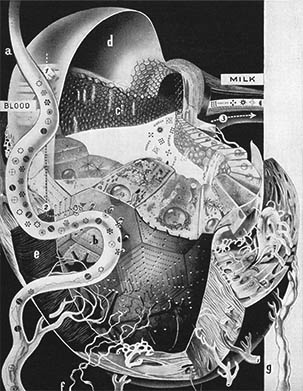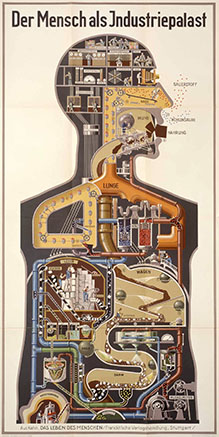59
Man in Structure and Function
Fritz Kahn
Fritz Kahn1 (28 Sep 1888 – 14 Jan 1968) was born in Halle, Germany, to the physician and writer Arthur Kahn and his wife Hedwig. He was raised as an orthodox Jew and received a liberal humanistic education, studying in Halle, later the Sophien-Gymnasium in Berlin, and finally the Friedrich Wilhelm Universität where he received a medical degree in 1912.
After receiving his doctorate he opened a gynecology practice in Berlin and began to write articles on popular science, notably for Gesellschaft der Naturfreunde’s Kosmos magazine.2 This led to several books published by Kosmos: Die Milchstrasse (The Milky Way) in 1914, Die Zelle (The Cell) in 1919, and in 1921 the first volume of Das Leben des Menschen (The Life of Man).
The cycle of carbon dioxide, ca.1929. Original scan courtesy Frank Darrow
The cycle of Virtue and Substance, ca.1929. Original scan courtesy Frank Darrow
The encyclopedic Das Leben,3 published in five volumes over the span of a decade, included over 1600 pages, more than 1200 illustrations, and would be Kahn’s opus. It was during this project that Khan perfected his modernist style of visualization, particularly his analogies of biology to industrial and mechanical processes – Man as Industrial Palace. It was a technique that would be heavily imitated over the next century.
The physiology of vision, 1931. From the NLM
Kahn, using Kosmos’ stable of illustrators, drew on nearly every contemporary style, including Neue Sachlichkeit, Dada, Surrealism, even Constructivist photomontage. His avant-garde visualizations were highly influential with Weimar-era designers, including Herbert Bayer and Walter Gropius of the Bauhaus.
The effect of sunlight, 1940. From the NLM
Man is an “eye” animal: a dog is a “nose” animal, 1943
By the 1930s Kahn, as a prominent Jew, was caught squarely in the growing anti-semitism of Nazi Germany. In 1933 his medical accreditation was revoked and his books were banned.4 Kahn’s biographical details become somewhat sketchy during this time: he apparently travelled to Jerusalem, Paris, Bordeaux, possibly Switzerland, and finally Lisbon. After a recommendation from Albert Einstein in 1941, Varian Fry issued an intellectual visa and the Kahns were able to escape to the US.
While on the run, however, he managed to publish two more books: Unser Geschlechtsleben5 (Our Sex Life) in 1935 and Der Mensch gesund und krank, Menschenkunde6 (Man in Structure and Function) in 1940.
The blood corpuscles, joined together in a chain, would span the globe 4 times, 1943
The work of the heart, 1943
Respiration, 1943
This is what occurs in our head when we see and say “Auto,” 1943
We see with the occipital area of the brain! 1943
Man in Structure and Function, essentially a distillation of Das Leben, received mixed reviews. The Quarterly Review of Biology wrote: “The most noteworthy feature of the publication consists in its 461 well reproduced illustrations, many of which are highly imaginative and most are instructive to a rare degree,” but also stated “At times, however, the desire for originality has gone to almost absurd extremes.”
Regardless of the reviews, however, Kahn’s books sold well in the US – body parts and sex have always been rather popular subjects.
The depths of a wound, 1943
The spinal cord, 1943
The mammary gland, 1943
In the 1950s Kahn returned to Europe, living in Switzerland and Denmark. Although he wrote several more popular science and love/marriage books, none were as popular as his earlier biology titles, and by the 1960s he found it difficult to get published. After his death in 1968 he left behind a somewhat forgotten legacy of 15 books, dozens of articles and nearly 2000 illustrations.
It would take almost forty years for a new generation of artists, designers and historians to rediscover and critically reassess his work.
The eruption dates of the milk teeth, 1943
1. For more information about Kahn's life and work see: Borck, C. Communicating the Modern Body: Fritz Kahn’s Popular Images of Human Physiology as an Industrialized World. Canadian Journal of Communication 1994 32(3): 495-520, which is available online, or, von Debschitz, Uta and Thilo. Fritz Kahn – Man Machine. New York: Springer, 2009. Here is the books’ site.
2. The new owners of the venerable publisher Franckh’sche Verlagshandlung began an amateur nature society, the Gesellschaft der Naturfreunde (The Friends of Nature Club) in 1903 as a response to a growing public interest in science and technology. With the success of their monthly magazine Kosmos (more than 100,000 subscriptions) they began publishing popular science titles under the imprint Kosmos Bücherei. After WWI, Franckh’sche Verlagshandlung began publishing not only science books, but crystal radios, science kits and games. Today, as Franckh-Kosmos Verlags-GmbH, they are best known as the publisher of Klaus Teubner’s spectacularly successful game Die Siedler von Catan (Settlers of Catan).
3. Kahn, Fritz. Das Leben des Menschen: Eine volkstümliche Anatomie, Biologie, Physiologie und Entwicklungsgeschichte des Menschen Anatomie (5 vol). Stuttgart: Kosmos Franckh’sche Verlagshandlung. Vol 1: 1922, vol 2: 1924, vol 3: 1926, vol 4: 1929, vol 5: 1931. Kahn’s famous poster Der Mensch der Industriepalast (illustrated by Georg Helbig) was intended as a special offer to those who initially subscribed in 1921. From the NLM:
4. Although this did not stop Gerhard Venzmer, editor at Franckh’sche Verlagshandlung, from publishing an unauthorized and uncredited edition of Das Leben with an added anti-Semitic chapter in 1939.
5. Kahn, Fritz. Unser Geschlechtsleben: Ein Führer und Berater für Jedermann. Zürich: Albert Müller Verlag, 1935; or Our Sex Life: A Guide and Counsellor for Everyone. New York: Alfred A. Knopf, 1939.
6. Kahn, Fritz. Der Mensch Gesund und Krank, Menschenkunde. Zürich: Albert Müller Verlag, 1940; or, Kahn, Fritz, Rosen, George (trans). Man in Structure and Function, 2 vol. New York: Alfred A. Knopf, 1943. Unless otherwise noted, all of the images here are from this title.
2 Mar 2010 ‧ Anatomicae
